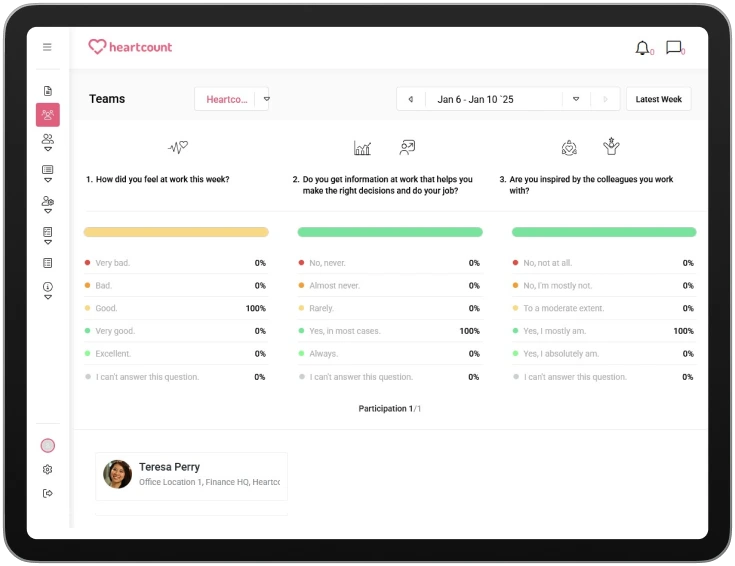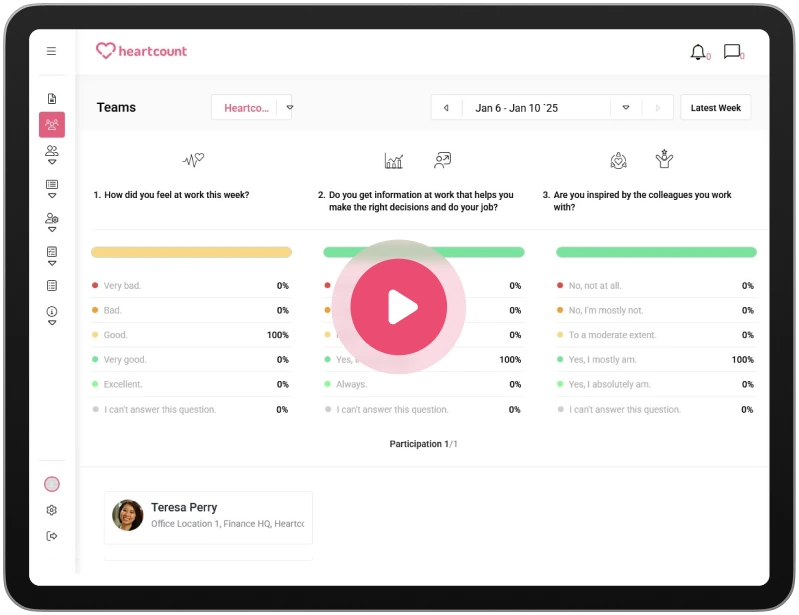Best 18 Employee Pulse Survey Questions That Employees Actually Want to Answer

Employee pulse checks in the form of short surveys can reveal how satisfied, engaged, and committed your employees are. The trick is asking the right questions, offering clear response choices, and understanding what the answers genuinely mean. Properly executed, these pulse checks provide actionable insights to foster a positive and productive work environment.
Below we share the best employee pulse survey questions, explain what the answers reveal about your company, and provide actionable tips on how to act on the feedback you collect to foster a positive and productive work environment.
Employee pulse checks in the form of short surveys can reveal how satisfied, engaged, and committed your employees are. The trick is asking the right questions, offering clear response choices, and understanding what the answers genuinely mean. Properly executed, these pulse checks provide actionable insights to foster a positive and productive work environment.
Below we share the best employee pulse survey questions, explain what the answers reveal about your company, and provide actionable tips on how to act on the feedback you collect to foster a positive and productive work environment.
Employee engagement
Employee engagement pulse checks provide insights into commitment, motivation, and overall sentiment of employees toward their work and the company. They help identify areas that need attention, ensuring employees feel valued.
Engagement pulse checks are most effective when conducted frequently, ideally weekly or bi-weekly. Regularity helps promptly identify issues, track changes over time, and measure the impact of any actions taken in response to previous feedback.
HeartCount’s CEO, Tijana Andjelic, suggests another way to track survey responses over time:
Employee individual profiles provide instant access to a timeline of each employee’s responses from the very first day of using HeartCount. This feature allows you to quickly and easily identify employee strengths and weaknesses in the work environment and professional relationships.
Tijana AndjelićPartner & CEO @ HeartCount
These employee pulse check questions provide the best insights into their engagement and happiness with their jobs:
1. Are you personally motivated to do your best at work?
What it reveals: Employee’s current drive and enthusiasm toward their work. The question indicates how engaged or disengaged they might feel about their daily tasks and overall role.
Response scale:
- 1 – Not at all
- 2 – Slightly
- 3 – Moderately
- 4 – Very
- 5 – Extremely
Actionable tips: To address low motivation, consider one-on-one meetings to discuss any obstacles your employees are facing or realign their tasks with their interests and strengths. Offering professional development opportunities and tailored perks based on employee needs or recognizing their achievements can also boost motivation.
2. Do you think that your work, dedication, and contribution to the company have been sufficiently recognized?
What it reveals: Employees’ perceptions of recognition and appreciation. These perceptions impact employees’ sense of belonging and worth within the organization, reflecting how well co-workers and management notices and values their contributions.
Response scale:
- 1 – Not at all
- 2 – Rarely
- 3 – Sometimes
- 4 – Often
- 5 – Highly
Actionable tips: Address low scores by acknowledging good work. You can do this through shout-outs in meetings, written praise in company communications, or formal recognition programs. Make sure managers are trained to give regular, constructive feedback.
3. Would you be happy to work for this company for many years to come?
What it reveals: Employees’ commitment to the company and their future with the organization. It can indicate job satisfaction, career growth prospects, and overall company morale.
Response scale:
- 1 – Definitely not
- 2 – Probably not
- 3 – Maybe
- 4 – Probably yes
- 5 – Definitely yes
Actionable tips: If scores suggest employees consider quitting, investigate why. The issue may be a lack of growth opportunities, dissatisfaction with the work environment, or other concerns. To prevent employees from leaving their jobs, provide clear career paths, ensure fair and competitive compensation, and foster a positive, inclusive work culture.
The saying that retaining an existing customer is 4 to 5 times cheaper than acquiring a new one applies to employees, who are a company’s greatest asset. HR tools can assist HR professionals in conducting their activities efficiently and reduce hiring and onboarding costs, especially for critical positions.
Dušan MihajlovićProduct Owner & Head of Data & Analytics @ HeartCount
Job satisfaction
Job satisfaction pulse checks help gauge employees’ satisfaction with their roles, responsibilities, and the work environment. Understanding these elements can help organizations improve job satisfaction, reduce turnover, and enhance productivity.
Conduct job satisfaction pulse surveys monthly or quarterly. This cadence allows enough time for implemented changes to be noticed by employees while providing regular feedback to keep the leadership informed and responsive.
4. If you take all the things into account, are you satisfied with your job?
What it reveals: This question measures employees’ contentment with their position and assigned tasks. It can highlight how well the role aligns with their skills, interests, and expectations. It can also reveal underlying issues related to workload, role clarity, or job fit.
Response scale:
- 1 – Very dissatisfied
- 2 – Somewhat dissatisfied
- 3 – Neutral
- 4 – Somewhat satisfied
- 5 – Very satisfied
Actionable tips: For low scores, explore specific areas of dissatisfaction through follow-up discussions or surveys. Adjust roles or responsibilities to align with the employee’s strengths and career aspirations. Ensure job expectations are clear and provide adequate support and resources for employees to effectively fulfill their responsibilities.
5. How would you rate your work-life balance?
What it reveals: How well employees feel they are managing their professional and personal lives. Their answers can indicate whether work demands encroach on personal time or whether the company culture supports a healthy balance.
Response scale:
- 1 – Very poor
- 2 – Poor
- 3 – Fair
- 4 – Good
- 5 – Excellent
Actionable tips: If employees have a poor work-life balance, introduce or encourage flexible work arrangements, such as remote work options or flexible hours. Ensure managers respect employees’ time outside work and give them reasonable workloads. Promote a culture that values personal time and well-being to improve work-life balance perceptions.
6. How likely would you recommend our company as a good workplace?
What it reveals: This question is akin to measuring the Net Promoter Score (NPS) for employee satisfaction. It assesses an employee’s overall perception of the company, including job satisfaction, culture, management, and growth opportunities.
Response scale:
- 1 – Not at all likely
- 2 – Unlikely
- 3 – Neutral
- 4 – Likely
- 5 – Extremely likely
Actionable tips: If the employees are unwilling to recommend the company, identify and address the underlying issues. Improve communication, enhance company culture, offer better benefits, or address specific employee concerns. Create a healthy work atmosphere in which employees feel appreciated and supported.
COLLECT
Professional growth and development
Regularly assessing professional growth and development through pulse checks ensures that employees are on a path to achieving their career goals while contributing positively to the organization’s goals. It also helps retain talent by showing a commitment to their personal and professional success.
These surveys should ideally be conducted quarterly. This time frame allows employees to experience and reflect on the professional development opportunities and feedback they’ve received. It also gives the organization a reasonable period to implement changes and observe their impact before the next survey cycle.
7. Do you feel you’re given opportunities to grow professionally?
What it reveals: This question measures an employee’s perception of personal and career development opportunities with the company. The answer can indicate how well the company supports upskilling, career advancement, and professional growth.
Response scale:
- 1 – Not at all
- 2 – Rarely
- 3 – Sometimes
- 4 – Often
- 5 – Always
Actionable tips: If the scores are low, consider enhancing or promoting professional development programs. Offer training sessions, workshops, mentorship programs, or clear paths for advancement. Ensure managers discuss career goals with their team members and actively support their growth and development.
8. Do you get enough feedback on your work?
What it reveals: The regularity and adequacy of communication between employees and their managers, specifically regarding feedback on performance and expectations. Regular feedback is crucial for employee growth, satisfaction, and alignment with company goals.
Response scale:
- 1 – Never
- 2 – Rarely
- 3 – Occasionally
- 4 – Frequently
- 5 – Always
Actionable tips: If feedback frequency is low, encourage managers to provide regular, constructive feedback. You can do it through formal performance reviews, regular one-on-one meetings, or informal daily or weekly check-ins. Ensure that the feedback acknowledges the accomplishments of your employees and that it provides clear and actionable advice for improvement.
9. Are you provided with all the necessary resources to do your job properly?
What it reveals: The availability and accessibility of professional resources indicate how well the company supports continuous learning and skill development. It reflects the company’s commitment to employee growth.
Response scale:
- 1 – Not at all
- 2 – With difficulty
- 3 – Somewhat easily
- 4 – Mostly easily
- 5 – Very easily
Actionable tips: If access to resources is an issue, invest in or expand your learning and development programs. Provide subscriptions to online courses, in-house training sessions, and workshops, or provide a budget for external training programs. Ensure that employees know the resources available and encourage managers to allow time for learning and development activities.
Company culture and values
Pulse checks focusing on company culture and values let you understand how well the company’s core values are integrated into daily operations and how they’re perceived by employees. They ensure that culture and values are not only declared but lived by all the members of your organization. Pulse checks help create a positive, inclusive, and supportive workplace in which all of your employees will feel appreciated and empowered.
Conduct these surveys quarterly or semi-annually. This frequency allows the company to assess the ongoing cultural dynamics and make necessary adjustments. It’s also a suitable time frame for observing the impact of any initiatives or changes implemented based on previous pulse check feedback.
10. Do you think that you and your company share the same values?
What it reveals: Employee’s sense of belonging and inclusion within the company. It shows how well the company’s values, behaviors, and practices resonate with your employees and whether they feel accepted and valued as part of the team.
Response scale:
- 1 – Not at all
- 2 – Rarely
- 3 – Sometimes
- 4 – Often
- 5 – Fully
Actionable tips: If scores are low, address inclusivity and diversity. Encourage open dialogue and feedback on company culture. Implement or strengthen diversity and inclusion training programs. Ensure that company events, communications, and policies are inclusive. Recognize and celebrate diversity in the workplace to foster a sense of belonging for everyone.
11. Do you think that employees in your company are encouraged to express their opinions freely?
What it reveals: The openness of the company culture and the extent to which employees feel their voice is valued and heard. It highlights the effectiveness of internal communication and the psychological safety within teams.
Response scale:
- 1 – Not at all
- 2 – Rarely
- 3 – Sometimes
- 4 – Often
- 5 – Always
Actionable tips: If the scores are low, foster a more open and inclusive culture. Encourage managers to actively seek input from team members and ensure that there are safe and structured channels for feedback and suggestions. Recognize and act upon feedback to demonstrate that employee opinions are heard, valued, and impactful.
12. Do you have a sense of belonging to your team and company?
What it reveals: Employee’s sense of acceptance, inclusion, and connection within their immediate team. The answer will indicate how well team members gel together, support each other, and create an inclusive and collaborative environment.
Response scale:
- 1 – Not at all
- 2 – Rarely
- 3 – Sometimes
- 4 – Often
- 5 – Always
Actionable tips: If the sense of belonging is low, focus on team-building activities and creating a supportive team environment. Encourage open communication, collaboration, and respect among team members. Regular team meetings, feedback sessions, and social events can strengthen bonds and create a more inclusive atmosphere. Ensure team leaders are approachable and foster a culture of trust and mutual support.
Managerial feedback
Managers’ feedback pulse checks help gauge how well managers support, guide, and communicate with their teams, which is vital for team performance, employee satisfaction, and overall organizational health. 78% of employees who had received acknowledgment from their managers in the previous month reported feeling motivated. That’s why regular evaluation of managers through feedback helps identify areas of strength and opportunities for improvement.
Conduct these surveys quarterly or bi-annually. This frequency ensures ongoing assessment of managerial impact and allows for timely adjustments based on feedback. It’s also a reasonable period to observe the effects of any managerial training or changes implemented.
13. Do you feel that your team lead cares enough about you?
What it reveals: The quality of the relationship between employees and their team lead, focusing on perceived care and personal interest. It’s a measure of supportive and empathetic leadership within a team, which can significantly affect employee satisfaction and retention.
Response scale:
- 1 – Not at all
- 2 – Barely
- 3 – Somewhat
- 4 – Mostly
- 5 – Absolutely
Actionable tips: If responses indicate that team leads are perceived as uncaring, address this issue. Encourage managers to engage more with their team members through regular one-on-one meetings. and to show interest in their professional development and personal well-being. Training them in compassionate leadership and communication can also help build stronger, more caring relationships within the team.
14. Are your accomplishments at work acknowledged or praised by your team lead?
What it reveals: The extent to which employees feel recognized and valued by their team lead. Recognition is key to employee motivation, job satisfaction, and loyalty. It reflects the culture of appreciation within the team and the organization.
Response scale:
- 1 – Never
- 2 – Rarely
- 3 – Sometimes
- 4 – Often
- 5 – Always
Actionable tips: To address this issue, encourage team leads to acknowledge and celebrate their team members’ successes in private and public settings. Ensure that praise is timely, specific, sincere, and tied to the company’s values and goals.
15. Does your team lead treat all of the team members equally?
What it reveals: The perceived objectivity and fairness of a team leader’s interactions and team leadership. These attributes help foster a healthy and inclusive team culture where all members feel valued and respected.
Response scale:
- 1 – Not at all
- 2 – Rarely
- 3 – Sometimes
- 4 – Often
- 5 – Always
Actionable tips: If the feedback suggests perceived inequality, address this issue by reinforcing the importance of fairness and equal treatment in leadership training. Encourage open dialogue and provide channels for feedback where team members can voice concerns without fear of retribution. Regularly review and adjust management practices to ensure they are fair and inclusive.
UNDERSTAND
Collegiality
Collegiality pulse checks focus on the quality of relationships and interactions among team members. They assess mutual support, trust, and respect within the team, which is essential for fostering a collaborative and positive work environment.
These surveys should ideally be conducted monthly. This frequency ensures that the team dynamics are regularly monitored and issues can be addressed promptly. It also allows the organization to recognize and reinforce positive behaviors and trends.
16. Do you have trust in the colleagues you work with?
What it reveals: The level of trust and mutual respect among team members. It’s crucial for understanding team dynamics and the overall collaborative spirit within the company. High trust levels typically correlate with better teamwork, communication, and job satisfaction.
Response scale:
- 1 – No trust at all
- 2 – Little trust
- 3 – Moderate trust
- 4 – High trust
- 5 – Complete trust
Actionable tips: If trust levels are low, focus on team-building activities and transparent communication. Encourage open discussions and address any underlying issues that may be eroding trust. Foster an environment where honesty and integrity are valued and commitments are consistently met. Let team members work together on projects and get to know each other personally to help them build trust.
17. What has your relationship with your colleagues been like this week?
What it reveals: The immediate, short-term dynamics and interpersonal relationships among team members. It helps identify whether there are any ongoing conflicts, high points of collaboration, or general mood shifts within the team, offering a snapshot of the team’s cohesiveness and morale.
Response scale:
- 1 – Negative
- 2 – Moderately negative
- 3 – Neutral
- 4 – Mostly positive
- 5 – Very positive
Actionable tips: Collaboration in a workplace impacts profitability (29%), sales growth (27%), profit growth (26%), and productivity (36%). If the feedback indicates negative or strained relationships, address this promptly. Facilitate a safe space for open dialogue to discuss and resolve conflicts. Encourage team bonding through social events or team-building exercises. Reinforce the importance of respectful communication, empathy, and supportiveness among team members.
18. Have you and the colleagues from your team been helping each other?
What it reveals: The level of support and collaboration among team members. It highlights the willingness of employees to assist each other, share knowledge, and work collectively towards common goals, indicating the strength of the team’s cooperative spirit.
Response scale:
- 1 – Not at all
- 2 – Rarely
- 3 – Sometimes
- 4 – Often
- 5 – Always
Actionable tips: If the scores suggest a lack of collaboration, encourage teamwork and mutual support. Promote sharing skills and knowledge through formal and informal mentoring or team sessions. Recognize and reward collaborative efforts. Ensure that team goals are clear and each member understands how their contributions support the team’s success.
Ready to apply the feedback you got?
With their focused and frequent approach, pulse checks offer valuable insights into various aspects of employee experience, from engagement and satisfaction to growth opportunities and managerial effectiveness.
HeartCount enhances the pulse check experience, offering weekly pulse checks and predictive turnover analytics for each employee, complete with a notification system for those at risk of leaving.
The platform is a straightforward and user-friendly solution that simplifies gathering employee feedback, streamlining the survey process with automatic reminders and multiple delivery options, including SMS, Slack, and email, and ensuring high participation rates without the need to chase down responses.











